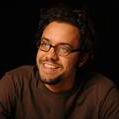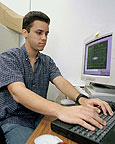Former Fermilab intern Rodríguez gives back
 |
| César Rodríguez |
Last month at a summer lecture, speaker César Rodríguez-Rosario, a postdoctoral fellow at Harvard University, cheerfully informed students of the following:
"If a person is quantum drunk, the curve of his walk does not look the same as for a person who's classically drunk."
Using such trenchant explanations, Rodríguez surveyed the world of quantum physics for the young standing room-only audience of summer interns with an easy clarity. He was returning a favor: he was a Fermilab intern himself in 2000 when the summer lectures sparked his interest in physics.
"I was enchanted by the summer seminars then," he said.
While a computer engineering major at the University of Puerto Rico, Rodriguez faced a choice between a NASA internship and Fermilab's Summer Internships in Science and Technology (SIST). It wasn't easy explaining to his parents how he could choose high-energy physics over the higher-profile field of space science.
Under the mentorship of physicist Chandrashekhara Bhat, Rodríguez worked on modeling beams for the Main Injector.
 |
| Rodríguez held a SIST internship in 2000. |
"I recall him saying, within the first week of his internship, that he might not pursue a career in physics," Bhat said. So he gave Rodríguez a two-week-long beam dynamics crash course. "He absorbed quite a bit and learned very fast."
Working in the company of other like-minded students helped.
"As interns, we would talk about physics until three in the morning," Rodríguez recalled.
After his Fermilab stint, he attended graduate school at the University of Texas at Austin, where he studied theoretical quantum mechanics. The first year was brutal. As an engineering major, he hadn't taken the undergraduate quantum physics courses that his peers had.
But he's done well for himself since, earning an Outstanding Teaching Assistant Award, two American Physical Society scholarships and his current Harvard fellowship, where he researches quantum effects in biological systems.
Even now, 10 years later, Rodríguez's internship work is still being used on 8 GeV antiprotons in the Main Injector.
"I think choosing SIST was the best decision I've made," Rodríguez said. "I was exposed to really good physics."
-- Leah Hesla
|